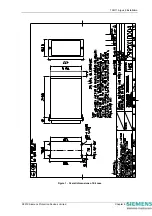
7SG11 Argus 8 Applications Guide
rise. This may be unacceptable to industrial loads, for example, where the running speeds of
synchronous motors will be affected.
In the situation where the system frequency is collapsing rapidly it is common practise to disconnect
non-essential loads for short periods of time, until the generation-load requirements and network
configuration can be corrected. This is designed to preserve system integrity and minimise outages.
Normally utilities will avoid intentionally interrupting service, but in this case non-critical loads can be
interrupted for short periods. This type of scheme is known as an underfrequency load shedding
scheme. Usually, automatic load shedding, based on underfrequency, is necessary since sudden,
moderate-to-severe frequency shifts can throw a system into a dangerous state much faster than an
operator can react. Underfrequency relays are usually installed at distribution substations, or industrial
plant, where selected loads can be disconnected and where similar priority loads are often grouped
together
.
The object of load shedding is to re-establish the generator-load equation. At the instant of a
disturbance a measure of the amount of overload is not readily available and thus load is shed in
stages until the frequency stabilises and returns to within the nominal band. An example scheme would
have the first load shedding stage set just below the nominal frequency, e.g. between 49.0 - 49.5Hz. A
time delay element would be associated with this and this would be set to allow for transient dips in
frequency, as well as to provide a time for the system regulating equipment to respond. The first load
shedding stage would be set to shed a significant percentage of the system load. If this drop is
sufficient, the frequency will stabilise and perhaps increase and return to nominal. If, however, this is
not sufficient then a second load shedding stage, set at a lower frequency, will now shed a smaller
percentage of load until the overload is relieved. This process will continue until all stages have
operated. In the event of the load shedding being unsuccessful, a final stage of underfrequency
protection should be provided to totally isolate all loads before plant is damaged, e.g. due to
overfluxing.
An alternative type of load shedding scheme would be to set all underfrequency stages to about the
same frequency setting but to have different length time delays set on each stage. If after the first stage
is shed the frequency doesn’t recover then subsequent stages will shed after longer time delays have
elapsed.
As has been mentioned earlier, where there is an excess of generation in a subsystem the frequency
will rise. This is most commonly due to loss of load situations, which cause the generators to speed up.
Normally the generator control equipment will respond to regain the normal running speed, but if this
equipment fails then the overfrequency protection can be used as a backup. The settings for the
overfrequency elements should be set to allow for transient frequency excursions following a loss of
load condition and allow time for the generator control systems to recover the situation.
The Argus 8 relay has four frequency elements, each of which can be set for underfrequency
operation. These, coupled with independent voltage elements and a large number of output contacts
available, enable economic application for complex load shedding schemes. The accuracy and security
of operation built into the numeric algorithms makes them ideally suited for this type of application. All
frequency elements can be blocked in a number of different ways. Section 1 - 3.5 of this manual
describes the ways in which this can be achieved. It is important to note that where there is other load
shedding equipment on a system, the Argus 8 relay should be set to co-ordinate with it.
©2010 Siemens Protection Devices Limited
Chapter 5 Page 7 of 16
















































